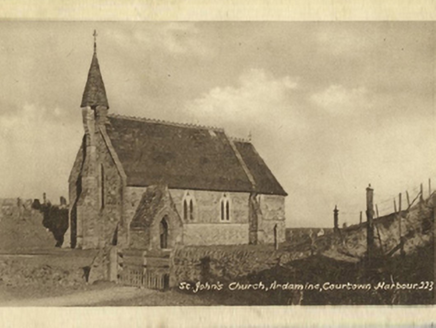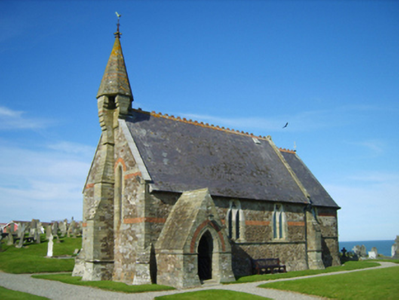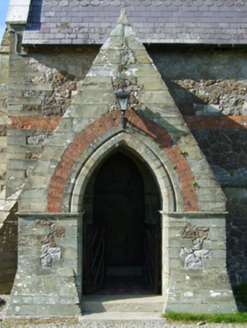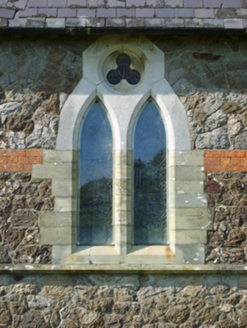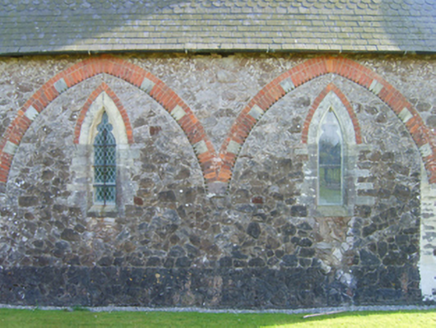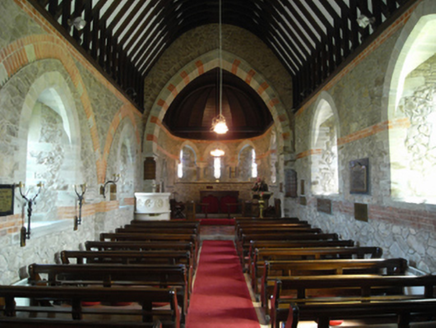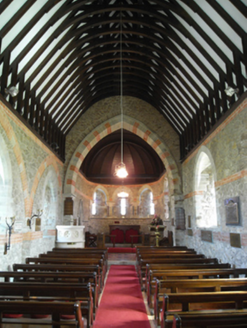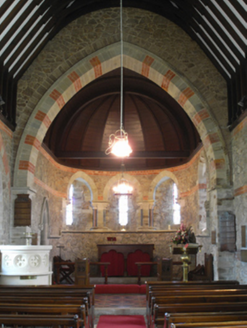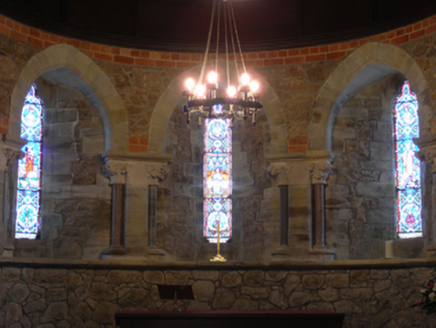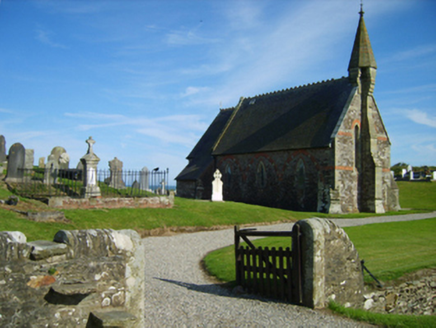Survey Data
Reg No
15701225
Rating
National
Categories of Special Interest
Architectural, Artistic, Historical, Social, Technical
Original Use
Church/chapel
In Use As
Church/chapel
Date
1855 - 1865
Coordinates
319811, 154843
Date Recorded
31/07/2007
Date Updated
--/--/--
Description
Detached four-bay double-height Church of Ireland church, built 1860-2; consecrated 1862, on a rectangular plan comprising three-bay double-height nave opening into single-bay double-height apse (east) on a bowed plan with single-bay single-storey gabled projecting open porch (south-west). Rededicated, 1915. Fish scale-coursed pitched slate roof; fish scale-coursed half-conical slate roof (east), crested terracotta ridge tiles, lichen-covered cut-granite "slated" coping to gables including lichen-covered cut-granite "slated" coping to gable to entrance (west) front with octagonal spirelet-topped buttressed bellcote to apex, and cast-iron rainwater goods on exposed rafters retaining cast-iron downpipes. Red brick English bond banded "Opus Incertum" walls on battered plinth with cut-Knockavocka stone buttresses including cut-Knockavocka stone diagonal buttresses to corners having lichen-spotted "slated" coping. Cusped lancet window openings (north) with hammered Knockavocka stone block-and-start surrounds having chamfered reveals framing storm glazing over fixed-pane fittings having margins centred on lattice glazing bars. Lancet window openings in bipartite arrangement (south) with lichen-spotted cut-Knockavocka stone chamfered sill course, and cut-or hammered Knockavocka stone block-and-start surrounds having chamfered reveals framing storm glazing over fixed-pane fittings having leaded stained glass panels. Cusped lancet window openings to apse (east) with lichen-spotted cut-Knockavocka stone chamfered sill course, and cut- or hammered Knockavocka stone block-and-start surrounds having chamfered reveals framing iron mesh storm panels over fixed-pane fittings having leaded stained glass panels. Paired lancet window openings to entrance (west) front with cut- or hammered Knockavocka stone block-and-start surrounds having chamfered reveals framing iron mesh storm panels over fixed-pane fittings having stained glass margins centred on leaded stained glass panels. Full-height interior open into roof with trefoil-detailed Caen stone baptismal font (west) below stained glass "West Window", carpeted central aisle between timber pews, wall monuments (ob. 1846; 1907), exposed timber roof construction on cut-granite chamfered cornice, quatrefoil-detailed Caen stone memorial pulpit (ob. 1846) on a circular plan with Gothic-style timber clerk's desk, and pointed-arch chancel arch framing encaustic tiled stepped dais to chancel (east) with turned timber colonette balusters supporting carved timber communion railing centred on timber altar table below stained glass memorial windows (1860). Set in landscaped grounds with lichen-spotted cut-granite monolithic piers to perimeter supporting timber gates.
Appraisal
A church erected to a design by George Edmund Street (1824-81) of London (Dublin Builder 1861, 554; 1862, 157) representing an important component of the nineteenth-century built heritage of County Wexford with the architectural value of the composition, one doubling as a memorial to Solomon Augustus Richards (1828-74) and Sophia Mordaunt Richards (née Ward) (1829-99) of nearby Ardamine House (see 15701229), confirmed by such attributes as the compact plan form, aligned along a liturgically-correct axis; the rock faced "Opus Incertum" stone work offset by pale green Knockavocka stone dressings not only demonstrating good quality workmanship, but also producing a mild polychromatic palette; the slender profile of the coupled openings underpinning a "medieval" Hard Gothic theme; and the spirelet-topped polygonal bellcote embellishing the roofline as a picturesque eye-catcher in the landscape. Having been well maintained, the elementary form and massing survive intact together with substantial quantities of the original fabric, both to the exterior and to the interior where contemporary joinery; restrained wall monuments; encaustic tile work; and vibrant stained glass supplied (1860) by Clayton and Bell (formed 1857) of London, all highlight the considerable artistic potential of the composition: meanwhile, a timber roof construction 'contrastingly treated in nave and chancel with only one truss exposed' (Williams 1994, 374-5) pinpoints the engineering or technical dexterity of a church making a picturesque visual statement on a cliff top overlooking the Irish Sea.
